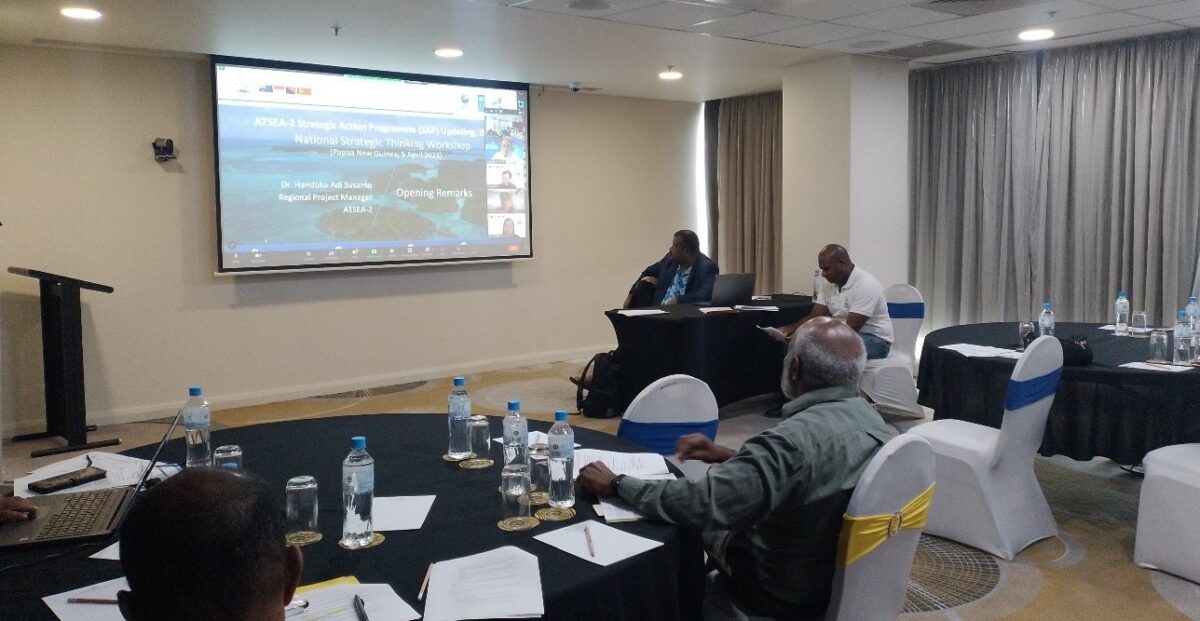The littoral nations of the Arafura and Timor Seas (ATS) region are united in their efforts to combat the depletion of marine and fishery resources. Recognising the significance of collaboration, the ATSEA-2 Project conducted the Strategic Thinking and Strategic Planning National Workshops in Port Moresby, Papua New Guinea (PNG), on 5 April and 5 May 2023, respectively. The primary objective of these workshops was to gather valuable national inputs to facilitate the drafting of the Strategic Action Program (SAP), and also use the opportunity to gather inputs for the National Action Programme (NAP) from the national stakeholders.
Stakeholders from different state agencies, NGOs and academe participated in the development of the SAP and NAP, including representatives from the Conservation and Environment Protection Authority (CEPA), National Oceans Office, National Fisheries Authority (NFA), United Nations Development Program (UNDP), Western Province Fisheries, South Fly District Fisheries and the University of Papua New Guinea.
In the National Working Group (NWG) workshops the four main components of the SAP, and by extension, of the PNG NAP were discussed and relevant details provided in the draft SAP. In the Strategic Thinking Workshop, the NWG reviewed the framework of the SAP containing the key components of the thematic issues and provided inputs on the priority actions. In the Strategic Planning Workshops the national team provided inputs on the contents of the draft SAP and established linkages to the NAP. PNG is developing its first NAP. Therefore, it has started early so is able to conduct its national consultations concurrently with SAP consultations.

For an updated assessment of the key transboundary environmental issues, interviews were conducted among coastal communities in the ATS region, including those within South Fly District. Mabudawan, a village chief from the South Fly District, has observed a significant decline in the size of fish and a noticeable reduction in fish stocks over the past five years. These concerning trends have been detrimental to local communities’ livelihoods and have had negative impacts on the ecosystem. Mabudawan’s observations reflect those of the other villages on the Fore Coast and highlight the urgent need for sustainable fishing practices and effective conservation measures in South Fly District. Furthermore, the ATSEA-2 Project conducted a Transboundary Diagnostic Analysis (TDA) along the Indonesia-Papua New Guinea border, which revealed specific issues that demand immediate attention, such as declining fish populations and habitat degradation.
Stakeholders have collaborated to address challenges by developing strategies for inclusion in the NAP. Notably, the introduction of the Artisanal Fisheries Management Plan (AFMP) empowers local communities to manage and protect their marine resources. This approach delegates responsibility, enabling communities to adopt sustainable fishing practices. Strategies include introducing village-specific fisheries management measures, incorporating local by-laws into government laws, controlling over-harvesting through penalties, integrating customary practices into management plans, and conducting continuous advocacy programs to raise awareness. The AFMP strives to empower communities and promote sustainable management practices.
Progress made at the national level in developing NAP will complement the ongoing efforts to create SAP at the regional level. These collaborative endeavours are vital for effective marine resource management in the ATS region. Given the heavy reliance of coastal communities on marine resources, it is crucial to promote responsible fishing practices. This includes avoiding overfishing, targeting adult fish rather than juveniles, and implementing appropriate fishing gear types.
Throughout the workshops, participants dedicated their efforts to developing comprehensive details regarding activities, indicators and timelines for priority actions. The discussions also offered a platform for national teams to align the SAP with the NAP, ensuring a coherent and cohesive approach. As a result, participants reached an agreement on the essential final steps required to review, complete, and endorse the SAP, solidifying their commitment to sustainable marine resource management in the ATS region.
Moving forward, the next steps will involve reviewing, finalising and endorsing the SAP, with a focus on consultation with other ATS countries to foster cooperation and shared concepts. Additionally, the adoption and implementation of the NAP within different state agencies, based on their respective roles, will be prioritised.
By Joe Kiningi


